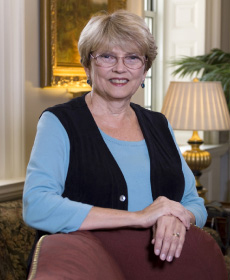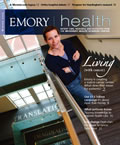Tapping patient knowledge

Emory patient and Candler theology graduate Elaine Plunkett is back on campus, this time to give vital input to improve health care services. She has worked on teams for building design and functional imaging and with nurses who are looking to improve reporting at change of shifts. |
by Rhonda Mullen
It was a crucial day for the breast cancer patient at Emory, a day when she'd find out whether her treatment had cured her cancer or had failed.
After her mammogram, she had to wait while a radiologist interpreted the results, and she was led into a small room with other vulnerable patients facing a similar scenario. She asked her technician if a friend could accompany her, to ease her mind while she waited. She was told "No." The reason? The waiting room was so small it could accommodate only those waiting for results. Still, the patient remembers, "In my most vulnerable moment, when I was most afraid and really needed someone I knew and trusted to sit with me, I was told I had to sit alone."
"It is stories like this that confirm our decision to move toward patient- and family-centered care at Emory Healthcare," says Hal Jones, director of care transformation. In his new role, Jones is helping the system invite patients and families to participate in decision-making to improve services. The breast cancer patient, who thankfully received a good prognosis on the day she waited alone, is just one of many patients Emory has recruited to help identify and fix flaws in design, communications, and care.
"We want to go beyond doing things for patients to doing things with them," Jones says. "We want to learn how to empower patients and their families so that their voices are heard and we learn from them. Patients and families can help us identify what's really going on, and they can point out areas where we can improve. And they can help us keep from making mistakes."
|
|
Jones is looking for volunteers who can describe the good and bad sides of their experiences and who aren't shy about speaking up. Eventually Emory Healthcare hopes to have patients serve on every key committee, participating in the design of waiting and hospital rooms, admissions materials, new faculty and staff recruitments, and services at all of Emory's hospitals and clinics.
Although it will take time to fully integrate these patient advocates, already more than a dozen have participated on advisory committees and projects at Emory hospitals. This fall, several former patients participated in a retreat that focused on how to achieve the ideal patient- and family-centered experience.
Who better than patients to advise the leaders? One pointed out that Emory admissions materials were written from the hospital point of view, telling patients how to pay and make decisions on advance directives before telling them what the Emory team was going to do to care for them. A mom of a patient admitted to Emory's neuro ICU reported that the open design and unrestricted visiting hours made her feel included in her son's healing. Others requested a daily, interactive posting on television screens in rooms to see when doctors would arrive and procedures were scheduled.
One patient is helping Emory Healthcare rewrite its disclosure policy. She originally came to Emory for emergency surgery on her elbow, but because of a series of errors, she ended up having surgery on the wrong elbow. Emory disclosed the mistake to the patient, and surgeons then performed an operation on the correct elbow. However, the woman left the hospital with two arms in slings, unable to function without help from her community. Adding insult to injury, Emory failed to contact the patient to check on her progress after she returned home, Jones is chagrined to report. When he met with her, she agreed to help. She said, "I want to make sure this doesn't happen to anyone else."
Jones wants to engage more of these kinds of patients. "That patient is able to transcend her own experience to see the bigger picture. She has the spirit of wanting to help us improve."
For most patients whom he's approached to sit on committees or volunteer advice, he's found an open reception. "I get the sense that they are thinking, 'What took you so long?'"



